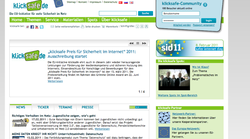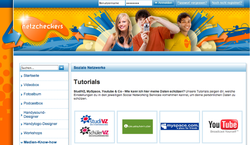Data protection in the Web
When using the internet and its seemingly infinite potential for students regarding social networks and certain learning tools, it is highly important to generate and to be aware of basic rules about data protection.
We, as future teachers, represent some kind of role model on how to do so. This is why we, in class, had to generate five basic rules how to protect oneself when using the internet. By comparing and discussing our own rules with the ones of other groups, it became quite clear that it is very important to not overload the students with a whole bunch of different regulations but rather to reduce those to the most essential ones.
During the task, some general guidelines on how to create rules, became quite clear. It is, for example, highly significant to always provide alternative options when one uses the phrase “don’t… do this or that”. Because if a teacher literally forbids a student to do something, he/she needs a suggestion on how to act differently. Also, one has to be specific about phrases such as “Be careful… with this or that” so that the students really know what they have to be careful about and what they could do instead. Even if those remarks seem to be minor details, they are very important if one really wants to help his/her students how to be safer in the world wide web.
Our group came up with the following rules.
1. Use different and safe passwords!
The "sentence-method", which we talked about in class, is a good method to create safe passwords.
2. Check which photos other people tag you in. Also make sure not to publish any pictures that need
permission which you do not have.
3. Be conscious of what information are visible for others!
This is especially important if you use any social networks in which you create personal profiles.
4. Always log out! This applies especially if you are working with a computer that is not your own.
5. Do not download unknown software!
In school, check what kind of software is allowed to be downloaded.
To make sure the students really do keep those rules in mind, I consider it as a very good idea to create those together in class. Just ask the students what they already know. One will probably be very surprised to find out how much that will be.

Also, one should give the students links which tell them the most important things to consider when using the internet.
I chose the following two links as I consider both of them as quite helpful and also easy to understand:
1. General Guidelines
This website, which I have called "general guidelines", is an initiative sponsored by the European agency. I thought it is especially useful as it provides a lot of information on how to be safe in the internet not just for young people and students but also for parents, teachers, and even for smaller children. The fact that parents and teachers are included, provides the possibility that they can, if they want to, inform themselves about what their children are doing in the internet and how they can advise them to properly behave when doing so. I really like the fact that the website provides different flyers specifically designed for different age groups.
I chose the following two links as I consider both of them as quite helpful and also easy to understand:
1. General Guidelines
This website, which I have called "general guidelines", is an initiative sponsored by the European agency. I thought it is especially useful as it provides a lot of information on how to be safe in the internet not just for young people and students but also for parents, teachers, and even for smaller children. The fact that parents and teachers are included, provides the possibility that they can, if they want to, inform themselves about what their children are doing in the internet and how they can advise them to properly behave when doing so. I really like the fact that the website provides different flyers specifically designed for different age groups.

2. Social networks
To get more specific information on how to safely use different social networks, "netzcheckers" is a really good website to visit. Beside "facebook", "studi-vz", or "schüler-vz", a great number of social networks coexist and students very often use more than one of those at the same time. This is why they need to know how to protect their personal data and this website gives very good advises on how to do so.
To get more specific information on how to safely use different social networks, "netzcheckers" is a really good website to visit. Beside "facebook", "studi-vz", or "schüler-vz", a great number of social networks coexist and students very often use more than one of those at the same time. This is why they need to know how to protect their personal data and this website gives very good advises on how to do so.
